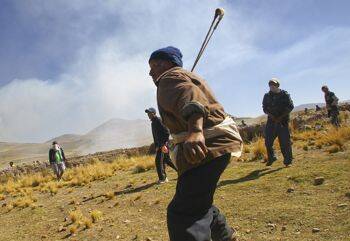Church leaders in Peru called for dialogue and expressed concern about the detention of two human rights workers in the southern Andes Mountains during violent protests over a copper mine. Two people have been killed and dozens, including police officers, have been injured in demonstrations against the Tintaya Mine, owned by Xstrata, a Swiss company. On May 28, the government imposed a 30-day state of emergency after the protest, which began the week before, turned violent on May 27. The mine, which local residents say pollutes water and soil in the area, is located in the Territorial Prelature of Sicuani, a church jurisdiction where most of the inhabitants are Quechua farmers. Environmental monitoring coordinated by the prelature has found high levels of metals in water and soil samples. The church workers were detained on May 28 after two lawyers from the prelature's human rights office persuaded demonstrators to free a government prosecutor who was investigating the protests. According to local reports, the lawyers accompanied the prosecutor to the mining camp, where some protesters were being held in a police station. While the two lawyers went inside with the prosecutor, their driver and another prelature employee were detained. Police later claimed that they had found ammunition in the vehicle. The detained workers were released on May 30, according to government reports. In a statement on May 29, U.S.-born Bishop Miguel La Fay Bardi of Sicuani and other prelature officials "categorically rejected" the accusation that ammunition had been found in the vehicle.
Indigenous in Peru Battle Copper Mining Interests
Show Comments (
)
Comments are automatically closed two weeks after an article's initial publication. See our comments policy for more.
The latest from america
Acceptance of changing tides was a major theme at the recent Conference of Major Superiors of Men National Assembly.
Catholic digital content creators reflect on their experiences at the Vatican's first-ever Jubilee of Digital Missionaries and Catholic Influencers.
Kerry Weber: “The Lilly grant is going to give us the opportunity to tell our stories in a more in-depth way and tell new stories that we may not have had the resources to tell otherwise.”
Nothing in my life has been as freeing as the realization that not everyone is going to love, like or approve of me.








